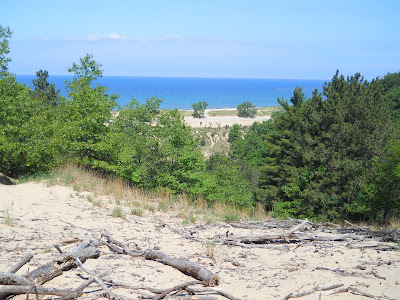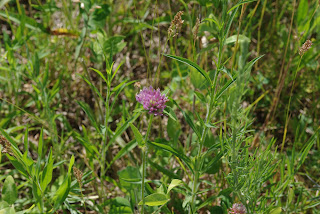“When we no longer look at an organic being as a savage looks at a ship,
as at something wholly beyond his comprehension; when we regard every
production of nature as one which has had a history; when we contemplate
every complex structure and instinct as the summing up of many
contrivances, each useful to the possessor, nearly in the same way as
when we look at any great mechanical invention as the summing up of the
labor, the experience, the reason, and even the blunders of numerous
workmen; when we thus view each organic being, how far more interesting,
I speak from experience, will the study of natural history become!”
― Charles Darwin, On the Origin of Species
 |
| Augusta Creek at Kellogg Forest |
Ecology as a field has been around only two hundred years. Of all the biological sciences, it is the most vast and comprehensive, and there is still an enormous amount of information we still do not know. Ecology itself is the study of interactions between organisms and the environment they reside in. However, interactions are dependent on a host of factors which influence every part of the environment and the parties involved.
In this regard, Ecologists are part of one of the most complex, intricate, demanding, and yet wonderful, new, and exciting interdisciplinary fields.
Today, I will take you on a trip through time; to the roots of ecology, and the people who shaped it and paved the way for us researchers today. These men and women were visionaries, yet many were met with contempt for their views. It is not only important to recognize them for the body of work they created, but often their bravery to share it when it undermined or overturned the traditional governing principles and paradigms.
 |
| Hippocrates |
It is impossible to start a discussion about the history of ecology without recognizing Hippocrates (460 B.C. - 370 B.C.). His theory on how diseases were transferred (by way of nature, not by Gods punishment) were revolutionary, and showed one of the very first causal relationships in nature. He was the first to categorize endemic versus epidemic diseases, which is a central, key ideal even today in understanding diseases among plants and animals alike.
Aristotle (384 B.C. - 322 B.C.) may have been the world's first interdisciplinary student, and later...teacher. His most known body of works are his contributions to logic, metaphysics, and ethics. However his writings on politics, government, theater, music, poetry, and physics are equally impressive and earn him a place in each of those fields discussions. His writings on biology and zoology are extensive, and were some of the first looks "under the skin" so to speak, of thousands of animals, by way of his dissections. His classification system stood for hundreds of years, and although there are faults in many of his views on the causes of differences in anatomical structures among animals, his understanding of their complexity gave rise to the field of biology that stands today.
 |
| Theophrastus |
Aristotle's greatest contribution to ecology may well have been his teachings, as his student, Theophrastus (371 B.C. - 287 B.C.), was one of the first people to document the interrelationship between animals and their environment. He wrote 18 books alone on plant structure, classification, and reproduction, and was pivotal in founding the field of botany.
These early theories, writings, and discoveries lasted for nearly two-thousand years before 17th century science finally had more questions to ask, and more answers to find. Much like the Copernican revolution changed the way we understood our place in the universe, that same time period changed the way we look at the world itself.
Antoni van Leeuwenhoecke (1632-1723), the father of microbiology, made significant contributions to the development of the microscope and was one of the first to see and categorize bacteria, protists, the cell vacuole, muscle tissue, and blood capillaries. He also began to look at and categorize food chains, and the roles microorganisms play in and on other organisms.
 |
| Carl Linnaeus |
Perhaps the next major step toward understanding how the environment works together was made by the one who broke it apart. Carl Linnaeus (1707-1778) cataloged and classified every organism he could find...and he was looking for plenty. He traveled far and wide, collecting, noting differences, and creating a hierarchical classification system, and a way to name each species. The Linnaean system of classification is still used today. While there are many flaws and it has been molded here and there for new evolutionary discoveries, it still served as a tremendous foundation for continuity in the scientific world, and the beginning of our understanding of evolutionary connectedness.
 |
| Charles Darwin |
The greatest contribution to ecology was made by one man, but many others were speaking through him. When Charles Darwin (1809-1882) joined the "Beagle" and began to capture and categorize all of the exotic wildlife he could find, he carried a book with him, Charles Lyell's, Principles of Geology. While noticing the layering of strata, and the presence of different fossils, an idea began to form in his head. The full realization of his theory, however, would not be realized until years later, after countless documentation, experimentation, and collaboration, when he stumbled upon Thomas Malthus, "An Essay on the Principle of Population." In this book, the idea of natural selection was soon formulated in Darwin's mind. As Malthus explained how population growth was exponential, yet food growth was linear, Darwin began to remember his time aboard the Beagle, and how many different fossils he had found that no longer existed as extent species. He realized that there must be something acting on them to keep population growth in check, and that only certain individuals must make it to reproduction. The theory of evolution by way of natural selection has been credited solely to Darwin, however, Alfred Russel Wallace deserves an accolade as well. It was in fact he who sent Darwin a short essay covering this exact phenomena and pleaded with Darwin to publish his book. Darwin struggled with his discovery til his death in 1882. As a very religious man, he knew he and his theory would be assaulted from the church; a battle that still rages today.
 |
| Gregor Mendel |
Another religious man also made an important discovery that
unfortunately went years before being found and it's importance
realized. Gregor Mendel (1822-1884), a friar, did meticulous work on germinating pea
plants and discovered that it was in fact a unit of inheritance that
passes along characteristics from one generation to another. His work,
now called Mendelian Genetics, is not only still taught today, but has
served as the starting point for nearly every biological science class
curriculum.
 |
| Rosalind Franklin |
That unit of inheritance was a complete mystery, until a team of Watson, Crick, and Franklin photographed and diagrammed the very first strand of DNA in 1953. Although only Watson and Crick are associated with the discovery by way of the Noble Prize, it is important to remember Rosalind Franklin's contribution as well. It was her X-ray photography that was finally able to capture the double helix.
 |
| Ernst Haeckel |
Karl Mobius (1825-1908), a German Zoologist, was the first to study community ecology and the living community. He was one of the pioneers of early ecology. However, the true father of ecology was Ernst Haeckel (1834-1919). Haeckel invented the term ecology, and popularized the research tie between ecology and evolutionary biology.
All in all, ecology has grown as a field rather quickly. In it's earliest roots it was the documenting, drawing, and naming of organisms. Later it was the study of their behavior, their genetics, and their anatomy. Later still, study turned to their relationships with other organisms and other communities. Today, ecology studies these interactions with both biotic and abiotic processes, together with an evolutionary understanding. In the future the study of ecology may change again, and lead to the study of creating ecosystems, restoring those that are nearly gone, and better understanding our role in protecting the thousands of habitats that make up our home...earth.
-Jason Lambracht













.JPG)


































